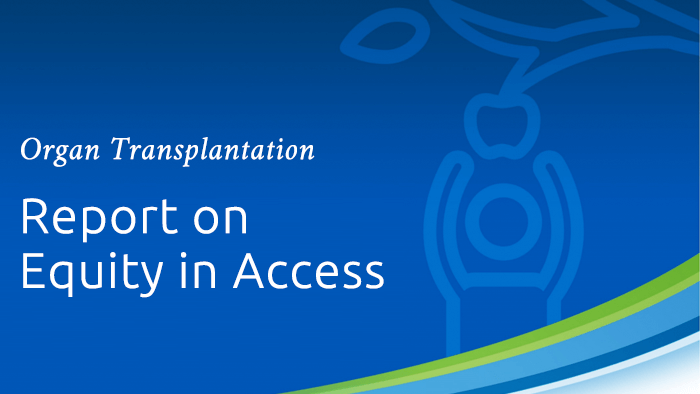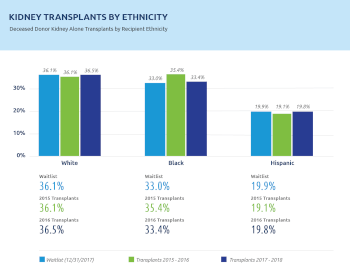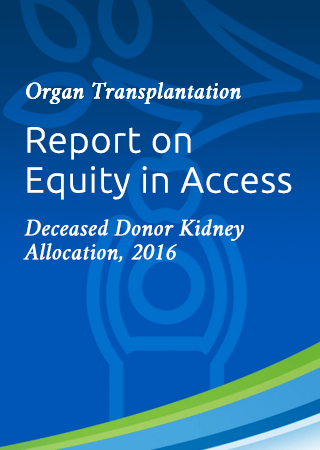
Insights: FEATURE
The Kidney Allocation System increases equity in access to kidney transplantation
Policy changes lead to improvements in the Kidney Allocation System
Is the Kidney Allocation System (KAS) accomplishing the goals set out for it?
After four years, the system has largely achieved the goals set out by the Organ Procurement and Transplantation Network Kidney Transplantation Kidney Transplantation Committee,” said David Klassen, MD, UNOS chief medical officer. “KAS has allowed many previously difficult to match patients to have access to kidney transplantation.” In January, UNOS staff researchers Darren Stewart and Amber Wilk, Ph.D., along with Klassen, published a review article, “KAS Turns Four: The State of Deceased Donor Kidney Allocation in the U.S.“, in a special issue of OBM Transplantation. The researchers compared the number and proportions of deceased donor kidney transplants by recipient and transplant characteristics from December 2013 through September 2018 and compared relevant trends before and after KAS implementation.
What is working and why?
In general, KAS has improved the equity of candidates’ access to kidney transplantation, notably by immune sensitization and candidate ethnicity.
“One way KAS was successful in improving equity was by giving very highly sensitized patients a fighting chance to get a kidney, in part due to awarding priority points along a ‘sliding scale’ based on the degree of sensitization,” said Stewart, the study’s lead author. However, for patients whose immune systems are so sensitized that they’re compatible with very few donors, the kidney committee recognized that points alone would not be enough: these patients would need access to a broader geographic pool of kidneys. In turn, KAS awarded the most highly sensitized patients with top-of-the-list priority for all kidneys recovered anywhere in the country.
“As expected, in the first few months after the new system went live, we saw a large spike in the number of these patients who received a transplant,” added Stewart, “since so many of them had been waiting for so long under a system that didn’t adequately accommodate their extremely long odds of being transplanted. Though fewer of these patients are being transplanted now, the percentage of transplants going to previously disadvantaged group remains much higher than before KAS and is closely aligned with the percent of the waiting list they represent.”
Another notable effect of KAS has been to essentially equalize the proportions of kidney transplant candidates and recipients by ethnicity.
Importantly, throughout the study period the number of deceased donor kidney transplants continued to increase. This trend began prior to KAS, so the ongoing rise in organ transplants is not necessarily attributable to the new system. It is, however, a positive finding that has remained steady over a sustained period before and after KAS’ introduction.
What challenges remain?
“It’s clear that while access to transplantation improved for ethnic minorities, geographic differences in access remain,” said Klassen. The geographic location of the transplant hospital (assessed by the hospital’s donation service area, or DSA) remains a primary driver in variation to transplant rates – a 17-fold difference from the DSAs with the highest and lowest transplant rates. “The OPTN is currently working to improve geographic disparities in access to transplantation of all organs,” Klassen added. (Read more about ongoing geographic distribution efforts.)
In addition, utilization of available deceased donor kidneys has remained largely unchanged overall, although since 2016 there has been a slight decrease in the percentage of kidneys recovered but not transplanted for KDPI values between 35 and 85 percent.
“Though the policy’s use of regional distribution of high KDPI kidneys did not lead to increased recovery or utilization as hoped the kidney committee has recently developed new policies to enhance KAS by fostering increased utilization of dual and en bloc transplants,” Stewart said. “We expect these policies, when implemented, to provide a boost to kidney utilization that helps more patients.”
Wilk notes other areas where the kidney committee seeks to further improve allocation. One is whether to increase priority for pediatric candidates. “Currently, pediatric patients are already receiving more priority than their wait list representation, but the ethical question of ‘is that enough’ still lingers.”
Another area for improvement may be ensuring more consistent priority for sensitized candidates. While access has greatly improved for the most highly sensitized, “It’s been noted that not all highly sensitized candidates are the same, so not everyone in that classification is receiving the same level of access,” Wilk said.
Measuring and monitoring equity in access to deceased donor kidney transplantation
Stewart DE, Wilk AR, Toll AE, Harper AM, Lehman RR, Robinson AM, Noreen SA, Edwards EB, Klassen DK. American Journal of Transplantation. 2018 Aug;18(8):1924-1935.
Read the article
Read more






